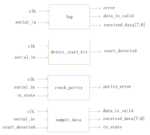promach
Advanced Member level 4
I have completed UART Tx coding in verilog.
So far, I wish to test the UART transmission, but I am not quite sure how to test it.
What should I test for ?
I am not asking for testbench code. I need some general guidance regarding testing UART softcore.
Thanks!
So far, I wish to test the UART transmission, but I am not quite sure how to test it.
What should I test for ?
I am not asking for testbench code. I need some general guidance regarding testing UART softcore.
Thanks!
Code Verilog - [expand]
Code Verilog - [expand]
Code Verilog - [expand]
Code Verilog - [expand]
Code Verilog - [expand]

